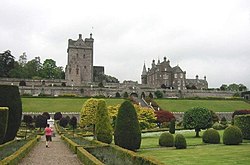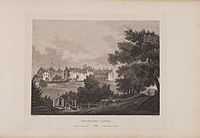Drummond Castle: Difference between revisions
Created page with "{{Infobox castle |name=Drummond Castle |county=Perthshire |picture=Drummond Castle & Gardens.jpg| |picture caption=Drummond Castle and gardens |os grid ref= |latitude=56.34..." |
No edit summary |
||
| Line 5: | Line 5: | ||
|picture caption=Drummond Castle and gardens | |picture caption=Drummond Castle and gardens | ||
|os grid ref= | |os grid ref= | ||
|latitude= | |latitude=56.34077 | ||
|longitude=-3.869508 | |longitude=-3.869508 | ||
|condition=Good | |condition=Good | ||
|built=15th, 17th centuries | |||
|garden=yes | |garden=yes | ||
|website= | |website= | ||
| Line 13: | Line 14: | ||
'''Drummond Castle''' is in [[Perthshire]]: a castle transformed into a stately home. Drummond is known for its gardens, described by [[Historic Scotland]] as "the best example of formal terraced gardens in Scotland."<ref name=garden>{{cite web |url=http://data.historic-scotland.gov.uk/pls/htmldb/f?p=2400:15:0::::GARDEN:GDL00144 |title=Drummond Castle |work=An Inventory of Gardens and Designed Landscapes in Scotland |publisher=Historic Scotland}}</ref> It is situated in [[Muthill]] parish, two and a half miles south of [[Crieff]]. | '''Drummond Castle''' is in [[Perthshire]]: a castle transformed into a stately home. Drummond is known for its gardens, described by [[Historic Scotland]] as "the best example of formal terraced gardens in Scotland."<ref name=garden>{{cite web |url=http://data.historic-scotland.gov.uk/pls/htmldb/f?p=2400:15:0::::GARDEN:GDL00144 |title=Drummond Castle |work=An Inventory of Gardens and Designed Landscapes in Scotland |publisher=Historic Scotland}}</ref> It is situated in [[Muthill]] parish, two and a half miles south of [[Crieff]]. | ||
The castle comprises a tower house built in the late 15th century, and a 17th-century mansion, both of which were rebuilt in Victorian times. The gardens date to the 1630s, although they too were restructured in the 19th century. The formal gardens are protected as a category A listed building,<ref>{{cite web |url=http://hsewsf.sedsh.gov.uk/hslive/hsstart?P_HBNUM=19883 |title=Drummond Castle, Formal Garden: Listed Building Report |publisher=Historic Scotland}}</ref> and are including on the 'Inventory of Gardens and Designed Landscapes in Scotland'.<ref name=garden/> The tower house and mansion are both category B listed.<ref>{{cite web |url=http://hsewsf.sedsh.gov.uk/hslive/hsstart?P_HBNUM=18078 |title=Drummond Castle, Keep: Listed Building Report |publisher=Historic Scotland}}</ref><ref>{{cite web |url=http://hsewsf.sedsh.gov.uk/hslive/hsstart?P_HBNUM=18042 |title=Drummond Castle, Mansion: Listed Building Report |publisher=Historic Scotland}}</ref> | The castle comprises a tower house built in the late-15th century, and a 17th-century mansion, both of which were rebuilt in Victorian times. The gardens date to the 1630s, although they too were restructured in the 19th century. The formal gardens are protected as a category A listed building,<ref>{{cite web |url=http://hsewsf.sedsh.gov.uk/hslive/hsstart?P_HBNUM=19883 |title=Drummond Castle, Formal Garden: Listed Building Report |publisher=Historic Scotland}}</ref> and are including on the 'Inventory of Gardens and Designed Landscapes in Scotland'.<ref name=garden/> The tower house and mansion are both category B listed.<ref>{{cite web |url=http://hsewsf.sedsh.gov.uk/hslive/hsstart?P_HBNUM=18078 |title=Drummond Castle, Keep: Listed Building Report |publisher=Historic Scotland}}</ref><ref>{{cite web |url=http://hsewsf.sedsh.gov.uk/hslive/hsstart?P_HBNUM=18042 |title=Drummond Castle, Mansion: Listed Building Report |publisher=Historic Scotland}}</ref> | ||
==History== | ==History== | ||
| Line 27: | Line 28: | ||
==Description== | ==Description== | ||
The castle is set on part of a prominent spine of rock known as the Gask Ridge, a geographical feature that stretches several | The castle is set on part of a prominent spine of rock known as the Gask Ridge, a geographical feature that stretches for several miles across [[Perthshire]], but is particularly prominent and steep-sided at the site of the castle. The tower house, or keep, is no longer used as a dwelling. It is adjoined by a later, but better preserved, gatehouse (built 1629–30). Stretching between the tower house and the edge of the ridge, it was originally intended to control access to the courtyard behind, which has a fine view over the formal gardens. To the south of the castle on its rocky outcrop are the formal gardens. | ||
==On film== | ==On film== | ||
| Line 41: | Line 42: | ||
==References== | ==References== | ||
{{reflist}} | {{reflist}} | ||
[[Category:Country houses in Perthshire]] | [[Category:Country houses in Perthshire]] | ||
Latest revision as of 14:37, 25 January 2019
| Drummond Castle | |
|
Perthshire | |
|---|---|
 Drummond Castle and gardens | |
| Location | |
| Location: | 56°20’27"N, 3°52’10"W |
| History | |
| Built 15th, 17th centuries | |
| Information | |
| Condition: | Good |
Drummond Castle is in Perthshire: a castle transformed into a stately home. Drummond is known for its gardens, described by Historic Scotland as "the best example of formal terraced gardens in Scotland."[1] It is situated in Muthill parish, two and a half miles south of Crieff.
The castle comprises a tower house built in the late-15th century, and a 17th-century mansion, both of which were rebuilt in Victorian times. The gardens date to the 1630s, although they too were restructured in the 19th century. The formal gardens are protected as a category A listed building,[2] and are including on the 'Inventory of Gardens and Designed Landscapes in Scotland'.[1] The tower house and mansion are both category B listed.[3][4]
History

The lands of Drummond were the property of the Drummond family from the 14th century, and the original tower house was built over several years by John Drummond, 1st Lord Drummond of Cargill, from about 1490. In 1605 the 4th Lord Drummond was created Earl of Perth, and added to the castle. John Drummond, 2nd Earl of Perth, laid out the first terraced garden around the castle in the 1630s.[5]
The castle was sacked by the army of Oliver Cromwell in 1653, during the Wars of the Three Kingdoms.[5] James Drummond, 4th Earl of Perth was Lord Chancellor of Scotland under King James VII. He began the mansion house in 1689, before being imprisoned following the deposition of King James by William of Orange. He later fled to the exiled Jacobite court in France. The Drummonds continued to support the Jacobite cause in the uprisings of 1715 and 1745. The family retained control of the estate until 1750 when the Drummond properties were declared forfeit and seized by the state.
The estate was managed by the Commissioners for Forfeited Estates until 1784, when it was sold to Captain James Drummond. He began a number of improvements that were continued by his daughter Sarah and her husband Peter Drummond-Burrell, 22nd Baron Willoughby de Eresby (1782–1865). These included the formal gardens and terraces in the 1830s. Queen Victoria visited the gardens in 1842.[5]

Drummond Castle passed to Clementina Drummond-Willoughby, 24th Baroness Willoughby de Eresby (1809–1888), and then to her son, Gilbert Heathcote-Drummond-Willoughby, 1st Earl of Ancaster (1830–1910). The upper stories of the tower house were rebuilt and heightened in pseudo-mediæval style in 1842–53. The mansion was renovated in 1878, to designs by George Turnbull Ewing. The 3rd Earl of Ancaster and his wife, Nancy Astor (daughter of the famous Lady Nancy Astor MP), replanted the gardens in the 1950s.[5] The castle is now the seat of the 28th Baroness Willoughby de Eresby.
Description
The castle is set on part of a prominent spine of rock known as the Gask Ridge, a geographical feature that stretches for several miles across Perthshire, but is particularly prominent and steep-sided at the site of the castle. The tower house, or keep, is no longer used as a dwelling. It is adjoined by a later, but better preserved, gatehouse (built 1629–30). Stretching between the tower house and the edge of the ridge, it was originally intended to control access to the courtyard behind, which has a fine view over the formal gardens. To the south of the castle on its rocky outcrop are the formal gardens.
On film
The buildings and gardens of Drummond Castle featured as backdrops in the 1995 film Rob Roy.
Outside links
| ("Wikimedia Commons" has material about Drummond Castle) |
- Drummond Castle Gardens
- Gazetteer for Scotland
- Flickr images tagged Drummond Castle
- Engraving of Drummond castle by James Fittler in the digitised copy of Scotia Depicta, or the antiquities, castles, public buildings, noblemen and gentlemen's seats, cities, towns and picturesque scenery of Scotland, 1804 - NLS
References
- ↑ 1.0 1.1 "Drummond Castle". An Inventory of Gardens and Designed Landscapes in Scotland. Historic Scotland. http://data.historic-scotland.gov.uk/pls/htmldb/f?p=2400:15:0::::GARDEN:GDL00144.
- ↑ "Drummond Castle, Formal Garden: Listed Building Report". Historic Scotland. http://hsewsf.sedsh.gov.uk/hslive/hsstart?P_HBNUM=19883.
- ↑ "Drummond Castle, Keep: Listed Building Report". Historic Scotland. http://hsewsf.sedsh.gov.uk/hslive/hsstart?P_HBNUM=18078.
- ↑ "Drummond Castle, Mansion: Listed Building Report". Historic Scotland. http://hsewsf.sedsh.gov.uk/hslive/hsstart?P_HBNUM=18042.
- ↑ 5.0 5.1 5.2 5.3 "Drummond Castle: Site history". An Inventory of Gardens and Designed Landscapes in Scotland. Historic Scotland. http://www.historic-scotland.gov.uk/index/heritage/gardens/gardenssearchmoreinfo.htm?s=drummond+castle&r=&bool=0&PageID=2416&more_info=Site.
